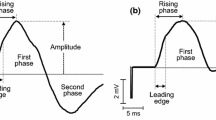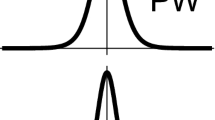Abstract
The extracellular action potentials (ECAPs) of single active muscle fibres immersed an isotropic volume conductor were investigated. The origination of excitation in the motor end-plate and its reaching the fibre end were taken into consideration. It was explained why at short radial distances the ECAPs over the fibre at points close to the end were similar in shape to the first time derivative and at points close to the motor end-plate-to the first time derivative of the intracellular action potential (ICAP) taken with minus sign. The fibre end changed the ECAP which would be recorded if the fibre was infinite and this change called pure termination potential (PTP) was a biphase positive-negative potential, proportional to the first time derivative of the ICAP at points close to the membrane and over the very end. With increasing the radial and axial distances PTP decreases in amplitude. Taking into account the PTP, the genesis of the terminal positive phase of the ECAPs (Gydikov and Kosarov 1972a, b) can be explained. The onset of the fibre or the motor end-plate also changed the potential which would be recorded if the fibre was infinite. This change was given the term of pure onset potential (POP)-a biphase negative-positive potential, proportional to the first time derivative of the ICAP taken with minus sign at a point close to the membrane and over the motor end-plate. With increasing the radial and the axial distance POP decreased in amplitude.
Close to the membrane PTP and POP were commensurable with the potential of an infinite fibre only at points close to the ends or to the motor end-plate. At long radial distances they were commensurable with the potential of an infinite fibre for all axial distances.
Similar content being viewed by others
References
Brooks GMcG, Eccles J.C. (1947) Electrical investigation of the monosynaptic pathways through the spinal cord. J Neurophysiol 10:251–274
Del Castilo J, Katz B (1954) The membrane change produced by the neuromuscular transmitter. J Physiol 125:546–565
Dimitrov GV, Dimitrova N (1974) Influence of the asymmetry in the distribution of the depolarization level on the extracelllar potential field generated by an excitable fibre. Electromyogr clin Neurophysiol 14:225–275
Dimitrova N (1973) Influence of the length of the depolarized zone on the extracellular potential field of a single unmyelinated nerve fibre. Electromyogr Clin Neurophysiol 13:547–558
Dimitrova N (1974) Model of the extracellular potential field of a single striated muscle fibre. Electromyogr Clin Neurophysiol 14:53–66
Dimitrova N, Dimitrov GV (1974) Extracellular potential field of a single striated muscle fibre. Electromyogr Clin Neurophysiol 14:279–292
Fatt P, Katz B (1951) An analysis of the end-plate potential recorded with an intra-cellular electrode. J Physiol 115:320–370
Gutman AM (1968) Dipole theory of the intracellular field (in Russian). Biofisika 13:679–684
Gydikov A, Kosarov D (1972a) Volume conduction of the potentials from separate motor units in human muscle. Electromyogr Clin Neurophysiol 12:127–147
Gydikov A, Kosarov D (1972b) Extraterritorial potential field of impulses from separate motor units in human muscle. Electromyogr Clin Neurophysiol 12:283–305
Gydikov A, Kosarov D (1974) Influence of the various factors on the length of the summated depolarized area of the muscle fibres in voluntary activating of the motor units and in electrical stimulation. Electromyogr Clin Neurophysiol 14:79–93
Gydikov A, Gerilovsky L, Radicheva N (1981) Dependence between intra-and extracellular potentials of isolated single frog muscle fibres. Proceedings of the 4th International Symposium on Motor Control Varna, 44–45
Janke E, Emde F, Lösch F (1960) Tafeln höherer Funktionen. Teubner, Stuttgart
Katz B (1966) Nerve, muscle, and synapse. McGraw-Hill, New York
Katz B, Miledi R (1965) Propagation of electric activity in motor nerve terminals. Proc R Soc London Ser B 161:453–482
Kostuk PG (1960) Microelectrode technique (in Russian). Izv Akademii Nauk USSR, Kiev
Lorente de No R (1947) A study of nerve physiology. Studies of the Rockfeller Institute for Medical Research 132
Miller-Larsson A (1985) An analysis of the extracellular single muscle fibre action potential field-modelling results. Biol Cybern 51:271–284
Orate M, Wright BE (1960) Intracellular recording of neuromuscular junction action potential in single isolated nervemuscle fiber. J Neurophysiol 23:646–658
Plonsey R (1974) The active fiber in a volume conductor. IEEE Trans Bio-Med Eng 21:371–381
Plonsey R (1977) Action potential sources and their volume conductor fields. Proc IEEE 65:601–611
Rosenfalck P (1969) Intra-and extracellular potential fields of active nerve and muscle fibres. Acta Physiol Scand Suppl 321:1–168
Schwarzacher HG (1966) Untersuchungen über die Skelettmuskel-Sehnenverbindung. III. Die Form der Muskelfaserenden. Acta Anat 43:144–157
Spach MS, Barr RG, Serwer GA, Kootsey JM, Johnson EA (1972) Extracellular potentials related to intracellular action potentials in the dog Purkinje system. Circ Res 30:505–519
Spach MS, Barr RC, Johnson EA, Kootsey JM (1973) Cardiac extracellular potentials—analysis of complex wave forms about the Purkinje networks in dogs. Circ Res 33:465–473
Trayanova N (1983) Influence of the changes in the velocity of spreading of the action potential on the distribution of the level of depolarization along an excitable fibre. Electromyogr Clin Neurophysiol 23:61–71
Trayanova N (1985a) Investigations on the dependence between intra-and extracellular potentials of single striated muscle fibres. Ph.D. Thesis, Sofia
Trayanova N (1985b) Influence of the fibre end on the calculated extracellular potentials of single muscle fibres. Electromyogr Clin Neurophysiol 25:443–451
Author information
Authors and Affiliations
Rights and permissions
About this article
Cite this article
Gydikov, A.A., Trayanova, N.A. Extracellular potentials of single active muscle fibres: Effects of finite fibre length. Biol. Cybern. 53, 363–372 (1986). https://doi.org/10.1007/BF00318202
Received:
Issue Date:
DOI: https://doi.org/10.1007/BF00318202




